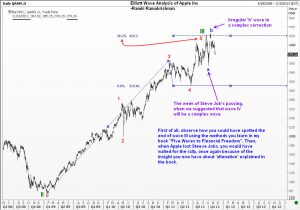Elliott Wave analysis of Apple stock (Nasdaq AAPL) was posted in WaveTimes on 5th October, when we paid our tribute to the late Steeve Jobs. I remembered that post when I saw some rumors that Apple was asking for its production of iPads to be slowed down. The charts that you see here seems to vindicate the belief that there is considerable value in using Elliott Wave Principle for our investment and trading decisions. Take a look. 
In the first chart, you will see the point ‘a’ is where we posted our previous analysis. At that time, we suggested that Wave III was already over, and we should expect wave IV to be a complex wave, meaning we will not go down directly, but there is a chance for a corrective pattern which will take us higher again. Sure enough, we were presented with an irregular B wave that went slightly higher than the top of wave III.
Could one have anticipated where the top of the irregular wave B will finish? Sure! Using the techniques that I have taught in the book “Five Waves to Financial Freedom” you could have identified a resistance very close to the actual top. This is illustrated in the second chart of Apple that you see here.
In addition, the chart shows you that when wave C of the complex correction started down, you could have used a 50% pull back (wave 2 of the big C wave) to initiate some fresh shorts. I am also giving you potential targets for the end of Wave IV. 
How confident can we be that it will work out again? Well, I have often maintained that in addition to solid analysis, you need to have sound money management techniques. I have said that we will probably not go above 390 now. So if you wish to have a low risk trade, you will probably wait for the fourth wave of the current C to take us slightly up and then sell. However, as always, you need to have a stop, because there are no guarantees in the market. We have a method that has worked over and over again. However, we also realize that one has to change tracks the moment something goes wrong. Elliott Wave analysis gives us a terrific edge in achieveing low-risk entry points and also identifying possible direction as well as extent of an impending move. What more can we ask for! In case you still have doubts, go back to the book and read the relevant sections. Good luck.

